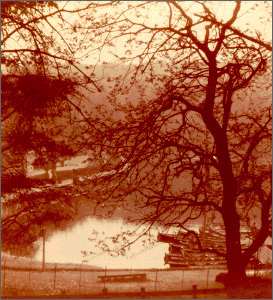|

Corner of Rudyard
Lake - early 1900's
Rudyard lake was
an extremely popular tourist attraction at the turn of the last century, and as
such became known as the "Blackpool of the Potteries". |
|
Rudyard Kipling, the
famous author, was named after Rudyard Lake.
Rudyard lake is an artificial
reservoir two miles long and a quarter of a mile wide built in 1831 to feed the
Macclesfield canal. Rudyard Kipling was named after the lake as a result of his
parents meeting there in 1863.
Rudyard is a small village which is
between Stoke-on-Trent and the moorlands town of Leek and is probably most famous for giving its name to
Rudyard Kipling. Kipling’s parents fell in love with Rudyard so much during
their courtship that they decided to name their son Rudyard.
|
| |
|
|
Rudyard itself gets
its name from Ralph Rudyard who is reputed to have slain Richard III at Bosworth. |
|
There are many attractions to see while visiting Rudyard, the lake (reservoir)
which feeds the local canal system is 2.5 miles long, it has sailing and rowing
boats for hire or you can steam up the lake in a rather antiquated steamboat,
there is also some excellent fishing. A narrow gauge steam railway with 1.3
miles of track runs from the car park along the side of the lake as far as
Hunthouse wood, there are intermediate stops allowing you to alight and explore
the area before catching a return train. Many interesting walks exist around
Rudyard and with two local hostelries no one need go home hungry or thirsty.

train at Rudyard Lake
| Railway
Web Site | |
|
Kipling's father, John Lockwood Kipling, was an artist and
scholar who had considerable influence on his son's work, became
curator of the Lahore museum, and is described presiding over this
“wonder house” in the first chapter of Kim,
Rudyard's most famous novel. His mother was Alice Macdonald, two
of whose sisters married the highly successful 19th-century
painters Sir Edward Burne-Jones and Sir Edward Poynter, while a
third married Alfred Baldwin and became the mother of Stanley
Baldwin, later prime minister. These connections were of lifelong
importance to Kipling.
John
Lockwood Kipling was involved in the decoration of the Victoria
and Albert Museum in London; He came to the Potteries to work for
the potter Pinder Bourne in Burslem.
In 1863 he and Robert Edgar
were awarded joint first prize in the competition for the design
of the facade and elevation of the Wedgwood Memorial Institute in
Burslem.

One of the terra-cotta panels from the
Wedgwood Institute in Burslem - designed by Rudyard Kipling's father
|
Kipling, Rudyard
born Dec. 30, 1865, Bombay, India
died Jan. 18, 1936, London, Eng.
in full Joseph Rudyard Kipling English
short-story writer, poet, and novelist chiefly remembered for his
celebration of British imperialism,
his tales and poems of British soldiers in India, and his tales for
children. He received the Nobel Prize for Literature in 1907.
Born in Bombay, British India, on December 30th 1865, Rudyard
Kipling was the first born child of John Lockwood Kipling and Alice
Kipling, who had settled in India earlier that year.
His father was a professor of architectural sculpture; on his
mother’s side there was a brace of distinguished Aunts and Uncles
for the boy. One Aunt was the mother of Stanley Baldwin, future
Prime Minister; another was married to Sir Edward Burne-Jones, the
distinguished Pre-Raphelite Painter. Kipling’s parents considered
themselves ‘Anglo-Indians’, and so too would their son, though
he in fact spent the bulk of his life elsewhere. Complex issues of
identity and national allegiance would become prominent features in
his fiction. |
 more on the Wedgwood Memorial Institute
more on the Wedgwood Memorial Institute
 more on Burslem
more on Burslem
|
![]() |
index page for 'did you know? |
|
index page for 'did you know? |